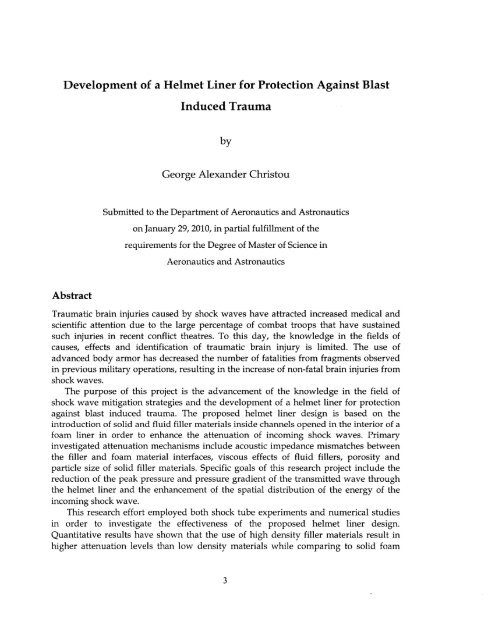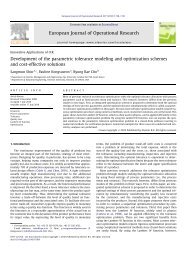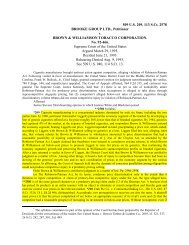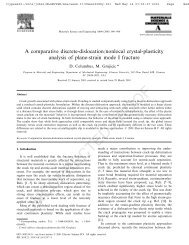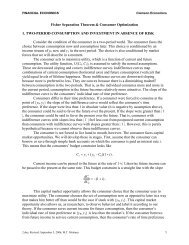- Page 1: Development of a Helmet Liner for P
- Page 5: Acknowledgments First and foremost,
- Page 8 and 9: 5 Experimental Blast M itigation St
- Page 10 and 11: Figure 5.5-4: PSD graph for free-fi
- Page 12 and 13: Figure 7.5-8: Pressure at moment of
- Page 15: List of Tables Table 3.3-1: Mass sp
- Page 18 and 19: combat related brain injuries was h
- Page 20 and 21: 0 The determination of optimal fill
- Page 23 and 24: 2 Blast Induced Traumatic Brain Inj
- Page 25 and 26: military conflicts [9]. A TBI is de
- Page 27 and 28: 2.2 Traumatic Brain Injury Research
- Page 29 and 30: Figure 2.2-1: DERAMan headform [20]
- Page 31 and 32: Xue and Hutchinson [24, 25] propose
- Page 33 and 34: 3 Fundamentals of Blast Wave Mechan
- Page 35 and 36: an underpressure of absolute magnit
- Page 37 and 38: p(t) = p0 + P+ 1 - j+ e-btT+ The ad
- Page 39 and 40: SECONDARY SHOCKS TERTIARY SHOCK Fig
- Page 41 and 42: p e+- dV +Jp e+ ii -nidS =- pii -id
- Page 43 and 44: where y: ratio of specific heats ai
- Page 45 and 46: V- aspects of the flow that are ind
- Page 47 and 48: atmosphere". We will frequently be
- Page 49 and 50: -I R -' KR Ta Figure 3.3-1: Hopkins
- Page 51 and 52: which the explosive blast has propa
- Page 53 and 54:
expressed as a function of the peak
- Page 55 and 56:
The subsequent motion of the plate
- Page 57 and 58:
pressure is the same. The formation
- Page 59 and 60:
p v U . U U, Equation 3.5-3 By subs
- Page 61 and 62:
4 Materials - Material Testing and
- Page 63 and 64:
4.1.1 Modeling of VN 600 foam throu
- Page 65 and 66:
700000 600000 400000 10 0 00 Uniaxi
- Page 67 and 68:
-- Hydrostatic Compression Testing
- Page 69 and 70:
1400000 1200000 -4000000 800000 800
- Page 71 and 72:
a-(e)= o -a Equation n 4.1-3 . wher
- Page 73 and 74:
After obtaining the scaled (o,E) an
- Page 75 and 76:
By substituting the experimentally
- Page 77 and 78:
cost. Therefore, it seemed logical
- Page 79 and 80:
0.29 0.15 55 20 0.1 0.6 0.20 85 40
- Page 81 and 82:
would lead to an increase of the re
- Page 83:
4.6 Air The air surrounding the sol
- Page 86 and 87:
measured pressure contained contrib
- Page 88 and 89:
products. Additionally, the HE cham
- Page 90 and 91:
not be constrained in the cavity du
- Page 92 and 93:
PhantIOM Mgjh speed cara lrnAnned t
- Page 94 and 95:
As mentioned in previous paragraphs
- Page 96 and 97:
materials, especially the aerogel a
- Page 98 and 99:
enchmark case for frequencies below
- Page 100 and 101:
0 0.5 1. -0.5 11 , , : -__ , rII _
- Page 102 and 103:
CL (0) 0.5 0 -0.5 IN-A 10 0 5 1.5 2
- Page 104 and 105:
Figure 5.5-7: Shadowgraph images du
- Page 106 and 107:
distribution of the transmitted wav
- Page 108 and 109:
108
- Page 110 and 111:
and spatial distribution of the res
- Page 112 and 113:
model the response of the cavity co
- Page 114 and 115:
Figure 6.1-5: Mesh dual for cavity
- Page 116 and 117:
loading. The solid sample and both
- Page 118 and 119:
[xl.E6] 0.4 00 -0.44 0.0 1.0 2.0 3.
- Page 120 and 121:
[xl.E6] 0.04 O'- 002 0.00 KA J I -0
- Page 122 and 123:
[x1.E3] 40.1- 30.- 10. 20. -20. - -
- Page 124 and 125:
[xl.E3] 20 -20- 0. 10 20 3!0 4.0 5!
- Page 126 and 127:
0.1 - 0 - -0.05- 3.05 0- 1.05 -0.1-
- Page 128 and 129:
Observation of Figure 6.2-10 corres
- Page 130 and 131:
[xl.E6] 0.40 - 0.20 ~; 0.00 -0.20-
- Page 132 and 133:
The profiles at locations C, H, J a
- Page 134 and 135:
0.1- 0, -0050- -01 - -016 -01 -0,05
- Page 136 and 137:
136
- Page 138 and 139:
other hand, in an Eulerian analysis
- Page 140 and 141:
for this study is depicted in the f
- Page 142 and 143:
[x1.E6J DAD DZD D.3D D. D D D " Tim
- Page 144 and 145:
a/7 B DBDD Z MD DA D Dii Di Time [s
- Page 146 and 147:
IncomingQ Shock Wave Parameters The
- Page 148 and 149:
There is a good agreement between t
- Page 150 and 151:
enable simulations of strong shocks
- Page 152 and 153:
examined artificial viscosity coeff
- Page 154 and 155:
Lx.E6j D. 7D Pre ss 122.5 m0./1 2 D
- Page 156 and 157:
Due to the restriction of the model
- Page 158 and 159:
Section A spans 500 mm above the to
- Page 160 and 161:
Due to the geometric symmetry of th
- Page 162 and 163:
Figure 7.4-7: External boundary of
- Page 164 and 165:
(depending on the simulation config
- Page 166 and 167:
etween the experimentally and numer
- Page 168 and 169:
epresented). An identical location
- Page 170 and 171:
7000 6000 5000 4000 3000 2000 1000
- Page 172 and 173:
5000 4000 3000- Pressure-Time - Exp
- Page 174 and 175:
[x1.E6] 0.50 0.40 C 0.30 - 0.20 --
- Page 176 and 177:
4400- A 40 2800 -- 3200 - -..-.- 24
- Page 178 and 179:
Figures 7.5-7 and 7.5-9 show the pr
- Page 180 and 181:
7.6 Conclusions Chapter 7 concerns
- Page 182 and 183:
182
- Page 184 and 185:
8.1 Summary and Conclusions The sig
- Page 186 and 187:
superior stress attenuation capabil
- Page 188 and 189:
Figure 8.2-1: Exploded view of prop
- Page 190 and 191:
190
- Page 192 and 193:
were observed for small strains esp
- Page 194 and 195:
101 Strain - Stress Rate T I T I- F
- Page 196 and 197:
196
- Page 198 and 199:
[x1.E6] 0.40 0.20 0.00 -0.20 Locati
- Page 200 and 201:
[x1.E3] 60.- 40. -20. -20. -40. Loc
- Page 202 and 203:
[xl-E6] L 0.04 0.02 0.00 -0.02- -0.
- Page 204 and 205:
[xlE6] 0.04 S0.00 -0.04 Location L
- Page 206 and 207:
The contour plots of the accumulate
- Page 208 and 209:
J00 0.055 emo aaam 2:mo am 001 1 .
- Page 210 and 211:
01 00 0.05 -01 10.05 01 -011 0.05 0
- Page 212 and 213:
14. Traumatic brain injury in the f
- Page 214 and 215:
41. S. Chen, Study on Mach Reflecti


